Calocybe gambosa (Fr.) Donk - St George's Mushroom
Phylum: Basidiomycota - Class: Agaricomycetes - Order: Agaricales - Family: Lyophyllaceae (NB: some authorities include Calocybe in the Tricholomataceae.)
Distribution - Taxonomic History - Etymology - Identification - Culinary Notes - Reference Sources
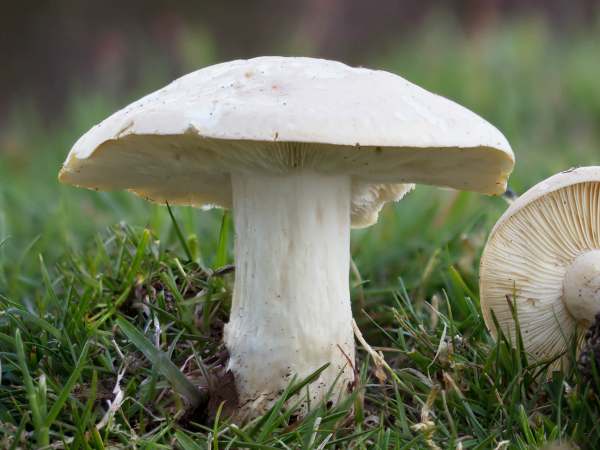
Appearing from April until June, Calocybe gambosa has the common name St George's Mushroom. It is a good edible species, distinguished from other pale species of springtime by its mealy (like wet flour) smell.
Calocybe gambosa is usually the first of the large edible fungi to appear. (The common name derives from St George's Day, 23rd April, by which date this mushroom can usually be found in Britain.)
Distribution
St George's Mushroom is an infrequent in most parts of Britain and Ireland, but it is locally plentiful and certainly worth searching for. This is one of the mushrooms that recurs in the same location for many years, often in scattered groups but occasionally in fairy rings. Calocybe gambosa is found throughout Europe and in North America. In Germany thius popular edible mushroom rarely appears before the beginning of May, and there it is known as Maipilz (May mushroom). In warmer Meditrerrannean countries Calocybe gambosa can be found in March, and hence its Italian name is Marzolino in reference to the month of its first emergence.
Taxonomic history
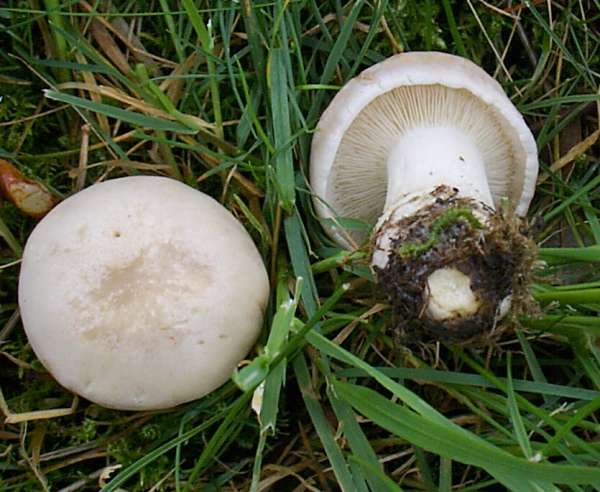
In 1753 Carl Linnaeus called this mushroom Agaricus georgii, but it was not until 1821 that it received its current specific epithet when it was described by Elias Magnus Fries, who named it Agaricus gambosus - most gilled fungi were placed in the Agaricus genus in the early days of fungal taxonomy. St George's Mushroom was later - Classified by German mycologist Paul Kummer as Tricholoma gambosum before Dutch mycologist Marinus Anton Donk (1908 - 1972) reclassified St George's Mushroom as Calocybe gambosa.
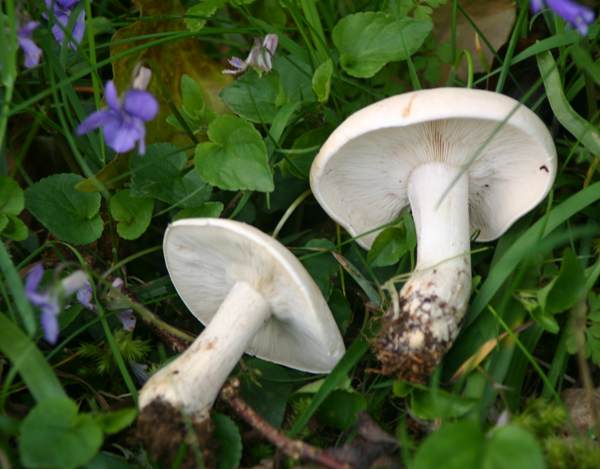
Being spectacular and edible, St George's Mushroom has inevitably grabbed the attention of great mycologists down the centuries. Synonyms of Calocybe gambosa include Agaricus georgii L., Agaricus albellus DC., Agaricus gambosus Fr., Tricholoma gambosum (Fr.) P. Kumm., Tricholoma georgii (L.) Quél., Calocybe georgii (L.) Kühner, and Lyophyllum gambosum (Fr.) Singer.
Etymology
The generic name Calocybe translates to 'pretty head' - a reference to the attractive caps of these edible mushrooms - while the specific epithet gambosa means 'club footed' and refers to the massive stem which often has a somewhat bulbous base.
Identification guide
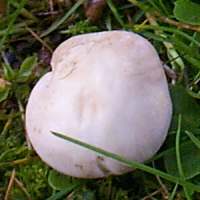 |
Cap5 to 15cm diameter; initially almost spherical, becoming convex and sometimes almost flat, the cap of a St George's Mushroom is often misshapen but generally retains a slightly incurved margin. The cap surface is smooth and white with a light brown tinge that sometimes becomes tan with age. Firm and white, the cap flesh is prone to maggot infestation as the fruitbody ages, and so only fresh young specimens are worth collecting. |
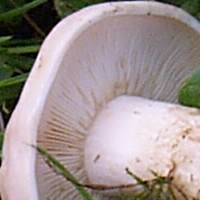 |
GillsThe sinuate gills of this mushroom are white, narrow and very crowded. Stem2 to 4cm wide and solid, usually curved and slightly thicker at the base, the stem is 3 to 7cm tall. There is no stem ring. |
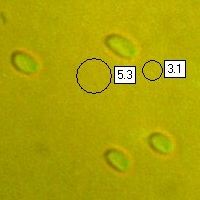 |
SporesEllipsoidal, smooth, 5-6 x 3-4µm. Spore printWhite. |
Odour/taste |
Mealy odour and floury taste (when uncooked). Cooking removes most of the mealy odour and taste and transforms this into a more delicious mushroom. |
Habitat & Ecological role |
In cropped pastures, often but not always near to deciduous tree,s and on mown roadside verges near to hedges; occasionally in mixed woodland. Calocybe gambosa is considered by some authorities to be a mycorrhizal species, although its habit of sometimes growing in rings is more generally associated with saprophytic fungi. St George's Mushrooms are very common in chalk- and lime-rich areas, but they also appear in moderately acidic grasslands and woodlands. I have found these mushrooms most often under Hazel, Beech, Oak and Silver Birch, but occasionally they occur near conifer hedges. |
Season |
April to June in Britain and Ireland; a month or so earlier in southern Europe but as late as June and July in Scandinavia. |
Similar species |
St George's Mushroom could be confused with the deadly poisonous Inocybe erubescens, the Deadly Fibrecap, which can appear at woodland edges towards the end of spring; its pale pink gills (rather than white like those of Calocybe gambosa) are adnexed and they turn red when bruised. The mealy smell of Calocybe gambosa helps in its identification, but other white fungi occur later in the year that also have a mealy odour - for example Clitopilus prunulus, The Miller, which has decurrent gills. |
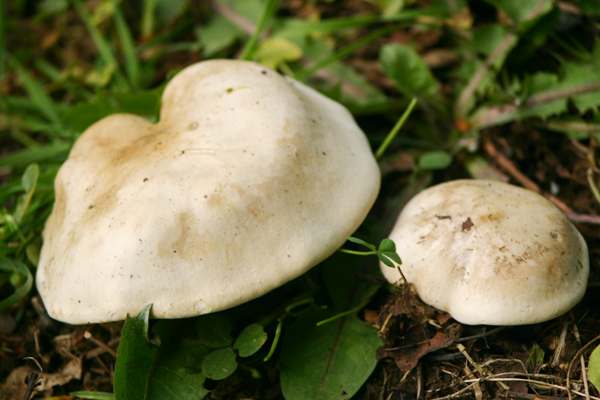
Culinary Notes
Calocybe gambosa is a good edible species and one of very few that are reputed to be safe to eat even when uncooked - although we always cook ours. St George's Mushroom can be used in any recipe calling for cultivated mushrooms. It is good in risotto dishes and omelettes, and it certainly has enough flavour to make tasty soups or sauces to be served with meat dishes. Like other fleshy fungi, St George's Mushrooms are prone to infestation by fly larvae (maggots), and so it is advisable to pick only young specimens for eating and to cut through each mushroom vertically to check for occupants.
Be particularly wary of gathering St George's Mushrooms from busy roadside verges, where they often appear but are likely to contain toxins accumulated in the soil from vehicle exhaust fumes, oil and other pollutants.
Reference Sources
Fascinated by Fungi, 2nd Edition, Pat O'Reilly 2016, reprinted by Coch-y-bonddu Books in 2022.
Dictionary of the Fungi; Paul M. Kirk, Paul F. Cannon, David W. Minter and J. A. Stalpers; CABI, 2008
Taxonomic history and synonym information on these pages is drawn from many sources but in particular from the British Mycological Society's GB Checklist of Fungi.
Acknowledgements
This page includes pictures kindly contributed by David Kelly.
Fascinated by Fungi. Back by popular demand, Pat O'Reilly's best-selling 450-page hardback book is available now. The latest second edition was republished with a sparkling new cover design in September 2022 by Coch-y-Bonddu Books. Full details and copies are available from the publisher's online bookshop...

